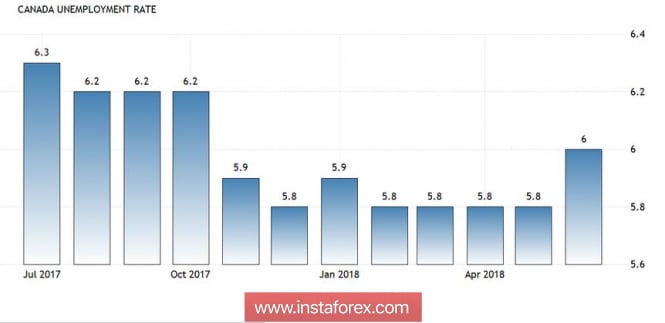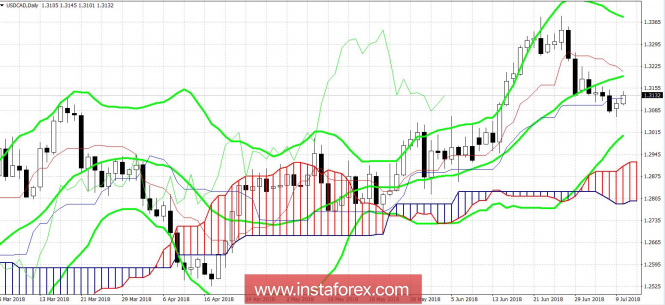The Bank of Canada will hold its July meeting on Wednesday. The probability of a rate hike at this meeting is more than 80%, but the Canadian dollar on the eve of the meeting of the regulator is behaving uncertain – in conjunction with the US currency, the "Loonie" trampled at the base of the 30th figure.
By and large, the traders of the USD/CAD pair have long been ready for the fact that the regulator will raise the interest rate in July or September. This has been repeatedly hinted at by members of the Canadian central bank over the past few months. In particular, Stephen Poloz last Thursday almost directly announced the imminent tightening of monetary policy against the background of positive dynamics of inflation. After his speech, the probability of a rate hike on July 11 increased from 50% to 80%. Therefore, we can say that traders have largely played this fact – over the past two weeks, the pair has fallen from the middle of the 33rd figure to the bottom of the 30th price level.
Given the experience of such situations (when the regulator's decision is largely predictable), there is no need to expect a rapid reaction to the very fact of the rate hike. The main attention of traders will be focused on the rhetoric of Stephen Poloz, who will hold a press conference an hour after the announcement of the meeting results. Market participants will be interested in the main issue – the future prospects of monetary policy, taking into account the growth of key macroeconomic indicators, and most importantly – taking into account the ambiguous trade relations between the US and Canada.
There should be no special claims to the dynamics of macroeconomic indicators, except for the latest release on the labor market. The fact that at the end of last week in Canada were published several conflicting data. The unemployment rate unexpectedly rose to 6%, although most experts said that the figure will remain at the same level – 5.8%. At this level, the indicator went out for four consecutive months, so its sudden growth was frankly disappointing.

As a counterbalance, data were provided on the growth in the number of employed. This figure reached almost 32 thousand - this is the fastest growth rate since December last year. The share of the economically active population also increased to 65.5%, despite the rather weak forecasts of experts. The average hourly rate, which is closely monitored by the Bank of Canada, increased by 3.6% last month.
In other words, the only flaw of the "Canadian non farm" is the unexpected rise in unemployment – as well as in the US. A number of experts explain such dynamics by the completion of the academic year and the search for temporary work by students. Others warn of a possible slowdown in the labour market, although there are fewer such pessimists. Stephen Poloz also hardly focuses on this fact - it is too early to talk about any negative trends. But the issue of Canada's foreign trade relations with the United States may affect the tone of his rhetoric.
Negotiations on the revision of the North American Free Trade Agreement (NAFTA) have been ongoing for a year, and have recently been suspended in connection with the presidential elections in Mexico. The election was over, the newly elected head of state expressed a desire to resume negotiations, but then the time-out took Donald Trump. He decided not to take any action until the midterm elections to the Lower House of Congress, which will be held on November 6. Thus, the fate of NAFTA again hovered in the air - most likely, before the end of this year.
The very fact of uncertainty in this matter is unnerving for the regulator: the head of the Bank of Canada has repeatedly spoken about NAFTA in the context of potential risks. But, unfortunately, this is not the only negative factor.
Let me remind you that on June 1, Washington removed Canada from the list of "beneficiaries", approving duties on imported steel and aluminum products – at the rate of 25% and 10%. The Canadians were not in debt and announced a response to economic measures against some American products. The response measures came into force only recently – on July 1. In turn, Donald trump is not going to stop there: he has repeatedly expressed his intention to introduce duties on imported cars and parts. For Canada, this will be a significant blow, as the country's automotive industry mainly consists of assembly plants of auto giants, and 70% of production is exported to the United States. At the moment, this Trump initiative is being studied by the relevant committee, so market passions on this issue have subsided slightly. However, it is impossible to exclude this factor from the list of risks.

In summary, macroeconomic indicators are helping to raise rates at Wednesday's meeting. However, this fact is already largely embedded in current prices. If Stephen Poloz focuses his attention on uncertainty, the loonie may be under pressure, despite the tightening of monetary policy. This scenario will trigger the growth of the USD/CAD pair to at least 1.3200, where the average line of the Bollinger Bands indicator coincides with the Tenkan-sen line on the daily chart.
The material has been provided by InstaForex Company - www.instaforex.com